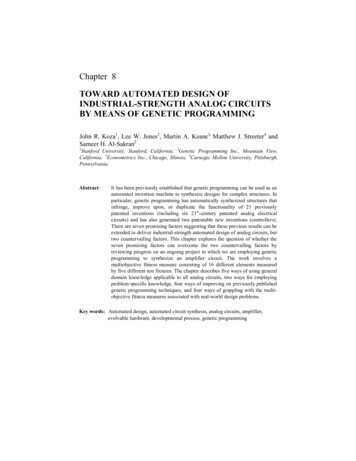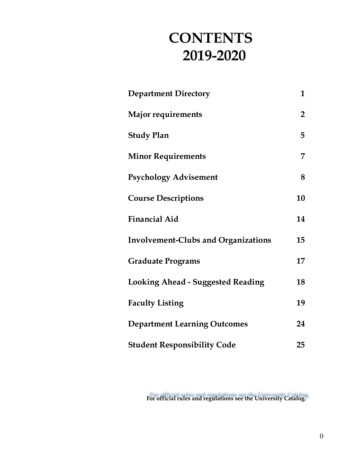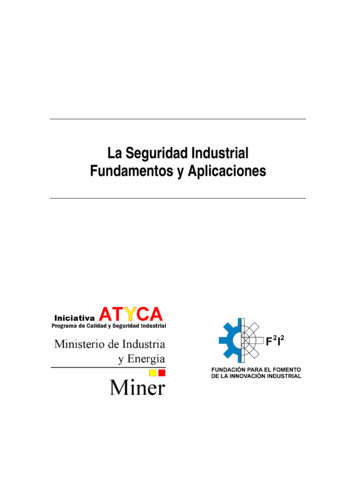
Transcription
Chapter 8TOWARD AUTOMATED DESIGN OFINDUSTRIAL-STRENGTH ANALOG CIRCUITSBY MEANS OF GENETIC PROGRAMMINGJohn R. Koza1, Lee W. Jones2, Martin A. Keane3, Matthew J. Streeter4 andSameer H. Al-Sakran21Stanford University, Stanford, California; 2Genetic Programming Inc., Mountain View,California; 3Econometrics Inc., Chicago, Illinois; 4Carnegie Mellon University, Pittsburgh,Pennsylvania.Abstract:It has been previously established that genetic programming can be used as anautomated invention machine to synthesize designs for complex structures. Inparticular, genetic programming has automatically synthesized structures thatinfringe, improve upon, or duplicate the functionality of 21 previouslypatented inventions (including six 21st-century patented analog electricalcircuits) and has also generated two patentable new inventions (controllers).There are seven promising factors suggesting that these previous results can beextended to deliver industrial-strength automated design of analog circuits, buttwo countervailing factors. This chapter explores the question of whether theseven promising factors can overcome the two countervailing factors byreviewing progress on an ongoing project in which we are employing geneticprogramming to synthesize an amplifier circuit. The work involves amultiobjective fitness measure consisting of 16 different elements measuredby five different test fixtures. The chapter describes five ways of using generaldomain knowledge applicable to all analog circuits, two ways for employingproblem-specific knowledge, four ways of improving on previously publishedgenetic programming techniques, and four ways of grappling with the multiobjective fitness measures associated with real-world design problems.Key words: Automated design, automated circuit synthesis, analog circuits, amplifier,evolvable hardware, developmental process, genetic programming
1221.GENETIC PROGRAMMING THEORY AND PRACTICE IIINTRODUCTIONGenetic programming is an automatic method for solving problems. It isan extension of the genetic algorithm (Holland 1975). Genetic programmingstarts from a high-level statement of the requirements of a problem andattempts to automatically create a computer program that solves theproblem. Specifically, genetic programming starts with a primordial ooze ofthousands of randomly created computer programs and uses the Darwinianprinciple of natural selection (fitness-based selection); analogs ofrecombination (crossover), mutation, gene duplication, gene deletion; andcertain mechanisms of developmental biology to progressively breed animproved population over a series of generations (Koza 1992, Koza 1994;Koza, Bennett, Andre, and Keane 1999; Koza, Keane, Streeter, Mydlowec,Yu, and Lanza 2003; Banzhaf, Nordin, Keller, and Francone 1998; Langdonand Poli 2002).Genetic programming can be used as an automated invention machine tosynthesize designs for complex structures. In particular, geneticprogramming has automatically synthesized complex structures that infringe,improve upon or duplicate in a novel way the functionality of 21 previouslypatented inventions (e.g., analog electrical circuits, controllers, andmathematical algorithms), including six post-2000 patented inventions.These 21 patented inventions are listed in Table 8.14.1 of (Koza, Streeter,and Keane 2003). In addition, genetic programming has generated twopatentable new inventions (both controllers) for which patent applicationsare currently pending (Keane, Koza, and Streeter 2002). Geneticprogramming has also generated numerous additional human-competitiveresults involving the automated design of quantum computing circuits(Spector 2004) and antennae (Lohn, Hornby, and Linden 2004). Geneticprogramming has generated results involving the automated design ofnetworks of chemical reactions and metabolic networks (Koza, Mydlowec,Lanza, Yu, and Keane 2001) and genetic networks (Lanza, Mydlowec, andKoza 2000).The six 21st-century patented inventions that were re-created by geneticprogramming were analog electrical circuits. Automatic synthesis of analogcircuits from high-level specifications has long been recognized as achallenging problem. As Aaserud and Nielsen (1995) noted:“[M]ost analog circuits are still handcrafted by the experts orso-called ‘zahs’ of analog design. The design process ischaracterized by a combination of experience and intuition andrequires a thorough knowledge of the process characteristics andthe detailed specifications of the actual product.
Toward Automated Design of Analog Circuits by GP123“Analog circuit design is known to be a knowledge-intensive,multiphase, iterative task, which usually stretches over asignificant period of time and is performed by designers with alarge portfolio of skills. It is therefore considered by many to be aform of art rather than a science.”And, as Balkir, Dundar, and Ogrenci (2003) stated:“The major reason underlying this lack of analog designautomation tools has been the difficulty of the problem, in ouropinion. Design in the analog domain requires creativity becauseof the large number of free parameters and the sometimes obscureinteractions between them. Thus, analog design has remainedmore of an ‘art’ than a ‘science.’ ”There are seven promising factors suggesting that the previous resultscan be extended to deliver industrial-strength automated design of analogcircuits and there are two countervailing factors that impede progress.One promising factor is the unusually high success rate of previous work.Multiple runs of a probabilistic algorithm are typically necessary to solve anon-trivial problem. However, all 11 runs involving the six post-2000patented circuits (ignoring partial runs used during debugging) yielded asatisfactory solution. This high rate suggests that we are currently nowherenear the limit of the capability of existing techniques.A second promising factor (discussed in section 2) is that geneticprogramming has historically demonstrated the ability to yield progressivelymore substantial results in synchrony with the relentless increase incomputer power tracked by Moore’s law (thereby suggesting that evermorecomplex problems can be solved as increased computer power becomesavailable).A third promising factor (discussed in section 3) is that our previouswork (and most other previous work) involving the automated synthesis ofcircuits intentionally ignored many pieces of elementary general domainknowledge about analog circuits. For example, none of our previous runsculled egregiously flawed circuits, such as those drawing enormous amountsof current or those that lacked a connection to the circuit’s incoming signal,output port, or power supplies. Instead, our previous work approached eachproblem with a relatively “clean hands” orientation—using as little humansupplied domain knowledge about electrical circuits as possible. Althoughthis “clean hands” orientation highlighted the ability of genetic programmingto produce human-competitive results in a “clean hands” setting, thisorientation is entirely irrelevant to a practicing engineer interested indesigning real-world circuits.A fourth promising factor (discussed in section 4) is that our previouswork (and most other previous work) intentionally ignored opportunities toemploy problem-specific knowledge about the to-be-designed circuit. For
124GENETIC PROGRAMMING THEORY AND PRACTICE IIexample, the starting point for circuit development in our previous runsusually consisted merely of a single modifiable wire. Genetic programmingwas then expected to automatically create the entire circuit from scratch.However, a practicing engineer does not start each new assignment fromfirst principles. Instead, the starting point for real-world design typicallyincorporates a core substructure that is known to provide a good head start.A fifth promising factor (also discussed in section 4) is that the geneticprogramming techniques used in our previous work to produce the six post2000 patented circuits were intentionally rigidly uniform. This uniformityhad the advantage of emphasizing the ability of genetic programming toproduce human-competitive results in a relatively “clean hands” setting. Forexample, we did not use automatically defined functions (subroutines) evenon problems with manifest parallelism, regularity, symmetry, andmodularity. However, a practicing engineer does not “reinvent the wheel” oneach occasion requiring an already known solution to a sub-problem.A sixth promising factor (discussed in section 5) is that currenttechniques used for circuit synthesis can be improved by applying variousaspects of the theory of genetic algorithms and genetic programming. Manyof the current techniques go back to early work on automated circuitsynthesis and have not been critically reexamined since then.A seventh promising factor is that considerable work has been done inrecent years to accelerate the convergence characteristics and generalefficiency of circuit simulators. For example, we used a version of theSPICE3 simulator (Quarles, Newton, Pederson, and Sangiovanni-Vincentelli1994) that we modified in various ways (as described in Koza, Bennett,Andre, and Keane 1999). Today, there are numerous commercially availablesimulators that are considerably faster (e.g., up to 10 times faster).There are, however, at least two countervailing factors that impedeprogress toward industrial-strength automated design of analog circuits.The first countervailing factor (discussed in section 6) concerns themulti-objective fitness measures that are typically associated with industrialstrength problems. The fitness measures used in previously publishedexamples of the synthesis of analog circuits by means of geneticprogramming (and genetic algorithms) typically consist of only a fewdifferent elements (rarely as many as four). In contrast, the data sheets usedto specify commercial circuits typically contain a dozen or more differentperformance requirements. It is difficult to quantify the tradeoff betweendisparate elements of a fitness measure. Moreover, as the number ofdisparate elements in a fitness measure increases, the strategy for combiningthe various (“apples and oranges”) elements of the fitness measure usuallybecomes vexatious. If, for example, gain, bias, and distortion (threecharacteristics that are relevant to amplifier design) are naively assigned
Toward Automated Design of Analog Circuits by GP125equal weight in a fitness measure, an unadorned wire will immediatelyachieve a very good score (because a wire introduces no distortion and nobias to an incoming circuit). What’s worse, almost any single modificationapplied to this wire will be highly deleterious—thereby creating a localoptimum from which escape is difficult. The search for an amplifier mayeasily become trapped in an area of the search space containing distortionfree and bias-free circuits that deliver no amplification at all. Thus, thehandling of the type of multi-objective fitness measures associated withindustrial-strength design problems is a major issue.The second countervailing factor arises from the need to evaluatecandidate circuits at the “corners” of various performance envelopes. Forexample, circuit behavior depends on temperature. A real-world circuitmight be required to operate correctly over a range between, say, –40 C and 105 C, not merely at room temperature (27 C). Separate simulations (or,if reconfigurable hardware is being used, separate test scenarios withdifferent ambient temperatures) are required to measure the circuit’sperformance at each corner of the temperature envelope. Each additionalsimulation multiplies the required computer time by a factor of two (if onlythe two extreme values are considered), three (if the nominal value and twoextremes are considered), or more (if more values are considered because ofnon-linear behavior). Similarly, a real-world circuit will be expected tooperate correctly in the face of variation in the circuit’s power supply (e.g.,when the battery or other power supply is delivering, say, 90% or 110% ofits nominal voltage). Again, separate simulations are required to measure thecircuit’s performance at each voltage corner. In addition, a real-world circuitwill be expected to operate correctly in the face of deviations between thebehavior of an actual manufactured component and the component’s“model” performance. For example, separate measurements may be requiredfor a entire circuit’s “fast,” “typical,” and “slow” behavior or when aparticular component is 75% or 125% of its nominal value. Circuits mayalso be expected to operate correctly in the face of variations in load, input,or other characteristics.Thus, the answer to the question as to whether genetic programming candeliver industrial-strength automated design of analog electrical circuitsdepends on whether the seven promising factors overcome the twocountervailing factors.The remainder of this chapter reports on progress on an ongoing projectin which we employed genetic programming to automatically synthesizeboth the topology and sizing of an amplifier circuit.
126GENETIC PROGRAMMING THEORY AND PRACTICE II2.ABILITY OF GENETIC PROGRAMMING TOPROFITABLY EXPLOIT INCREASEDCOMPUTER POWERGenetic programming generally requires significant computationalresources to solve non-trivial problems. Fortunately, the computer timenecessary to achieve human-competitive results has become increasinglyavailable in recent years because (1) the speed of commercially availablesingle computers continues to double approximately every 18 months inaccordance with Moore’s law, (2) genetic programming is amenable toefficient parallelization, and (3) Beowulf-style parallel cluster computersystems can be assembled at relatively low cost.As shown in Table 8-1, GP has historically demonstrated the ability toyield progressively more substantial results, given the increased computerpower tracked by Moore’s law. Column 1 lists the five computer systemsused to produce our group’s reported work on GP in the 15-year periodbetween 1987 and 2002. Column 4 shows the speed-up of each system overthe system shown in the previous row of the table. Column 7 shows thenumber of human-competitive results generated by each computer system.Table 8-1. Human-competitive results produced by GP with five computer systems.SystemPeriodPetacyclesper daySpeed-up overfirst systemUsed for work ytecmachine70-nodeAlphamachine1,000-nodePentium IImachine1987–19940.0021 (base)GeneticProgramming I and II01994–19970.029A few problems inGeneticProgramming III21995–20000.44204121999–20013.21,481Most problems inGeneticProgramming III8 of problems inGeneticProgramming IV2000–200230.013,90028 of the problems inGeneticProgramming IV122
Toward Automated Design of Analog Circuits by GP127The first entry in Table 8-1 is a serial computer and the next four entriesare parallel computer systems. The presence of four increasingly powerfulparallel computer systems reflects the fact that genetic programming hassuccessfully taken advantage of the increased computational power availableby means of parallel processing.Table 8-1 shows the following: There is an order-of-magnitude speed-up (column 3) between eachsuccessive computer system in the table. Note that, according toMoore’s law, exponential increases in computer powercorrespond approximately to constant periods of time. There is a 13,900-to-1 speed-up (column 4) between the fastest andmost recent machine (the 1,000-node parallel computer system)and the slowest and earliest machine (the serial LISP machine). The slower early machines generated few or no human-competitiveresults, whereas the faster more recent machines have generatednumerous human-competitive results.Four successive order-of-magnitude increases in computer power areexplicitly shown in Table 8-1. An additional order-of-magnitude increasewas achieved by making extraordinarily long runs on the largest machine inthe table (the 1,000-node Pentium II parallel machine). The length of therun that produced the genetically evolved controller for which a patentapplication is currently pending (Keane, Koza, and Streeter 2002) was 28.8days—almost an order-of-magnitude increase over the 3.4-day average forruns that our group has made in recent years. If this final 9.3-to-1 increase iscounted as an additional speed-up, the overall speed-up is 130,660-to-1.Table 8-2 is organized around the five just-explained order-of-magnitudeincreases in the expenditure of computing power. Column 4 of this tablecharacterizes the qualitative nature of the results produced by geneticprogramming. This table shows the progression of qualitatively moresubstantial results produced by genetic programming in terms of five orderof-magnitude increases in the expenditure of computational resources.The order-of-magnitude increases in computer power shown in Table 8-2correspond closely (albeit not perfectly) with the following progression ofqualitatively more substantial results produced by genetic programming: toy problems, human-competitive results not related to patented inventions, 20th-century patented inventions, 21st-century patented inventions, and patentable new inventions.
128GENETIC PROGRAMMING THEORY AND PRACTICE IIThe progression in Table 8-2 demonstrates that genetic programming isable to take advantage of the exponentially increasing computational powertracked by iterations of Moore’s law.Table 8-2. Progression of qualitatively more substantial results produced by geneticprogramming in relation to five order-of-magnitude increases in computational power.SystemPeriodTexasInstrumentsLISP chine1987–1994Speed-upover previous1 (base)Qualitative nature of the results produced bygenetic programming Toy problems of the 1980s and early 1990sfrom the fields of artificial intelligence andmachine learning Two human-competitive results involving onedimensional discrete data (not patent-related)1994–199791995–20002270-node Alphamachine1999–20017.31,000-nodePentium IImachine2000–20029.4 Numeroushuman-competitiveresultsinvolving continuous signals analysed in thetime domain Numerous general solutions to problems in theform of parameterized topologies Six human-competitive results duplicating thefunctionality of 21st-century patented inventions4-week runsof 1,000-nodePentium IIparallelmachine20029.3 Generation of two patentable new inventions One human-competitive result involving twodimensional discrete data Numeroushuman-competitiveresultsinvolving continuous signals analysed in thefrequency domain Numeroushuman-competitiveresultsthinvolving 20 -century patented inventions One human-competitive result involvingcontinuous signals analysed in the time domain Circuit synthesis extended from topology andsizing to include routing and placement (layout)
Toward Automated Design of Analog Circuits by GP3.129EXPLOITING GENERAL KNOWLEDGE ABOUTCIRCUITSThe previously reported work involving the six 21st-century patentedcircuits intentionally did not take advantage of even the most elementarydomain knowledge applicable to analog circuits. As part of our ongoingproject of synthesizing commercially marketed amplifier circuits by meansof genetic programming, we have incorporated general domain knowledgeabout circuits into our work in several ways.First, in previously reported work, the initial population was createdentirely at random and new individuals were created during the run using theusual problem-independent probabilistic genetic operations (e.g., crossover,mutation). Many individuals in these populations inevitably representunrealistic or impractical electrical circuits. One particularly egregiouscharacteristic of some circuits is that the circuit fails to make a connection toall input signals, all output signals, and all necessary sources of power (e.g.,the positive power supply and the negative power supply). Circuits that donot satisfy these threshold requirements are now being culled from thepopulation (by severe penalization). The removal of such egregiously flawedcircuits not only conserves computational resources, but also increases theamount of useful genetic diversity of the population (thereby furtheraccelerating the evolutionary process).Second, another egregious characteristic of some circuits in unrestrictedruns is that the circuit draws preposterously large amounts of current. Inorder to cull circuits of this type from the population, each circuit isexamined for the current drawn by the circuit’s positive power supply andnegative power supply. Circuits that draw excessive current are now beingculled from the population.Third, the components that are inserted into a developing circuit need notbe as primitive as a single transistor, resistor, or capacitor. Instead,component-creating functions can be defined to insert frequently occurringcombinations of components that are known to be useful in practicalcircuitry. Examples include current mirrors, voltage gain stages, Darlingtonemitter-follower sections, and cascodes. Graeb, Zizala, Eckmueller, andAntreich (2001) identified (for a purpose entirely unrelated to evolutionarycomputation) a promising set of frequently occurring combinations oftransistors that are known to be useful in a broad range of analog circuits.For the present work, we have implemented circuit-constructing functionsthat insert a current mirror, two types of voltage references, a loaded currentmirror, and a level shifter from among these two-transistor groups. Forcertain problems, the set of primitives can be expanded to include higherlevel entities, such as filters, amplifiers, and phase-locked loops.
130GENETIC PROGRAMMING THEORY AND PRACTICE IIFourth, minimization of a circuit’s total area is of great practicalimportance because the cost of manufacturing a chip depends directly on itssize (because a given wafer contains more copies of a smaller chip andbecause a particular flaw on a wafer has a less deleterious effect on thewafer’s yield percentage when the flawed chip is smaller). Resistors areoften implemented on a silicon chip by laying down a serpentine chain ofsmall patches of resistive material. Capacitors are often created by layingdown two areas of conductive material. Thus, in many situations, a circuit’soverall size is heavily influenced by the number of its resistors andcapacitors. Our previous work on circuit synthesis typically permitted thecreation of resistor and capacitor values over a very wide range (e.g., 10orders of magnitude). Practical work requires choices of component valuesthat lie in a particular range of only about three orders of magnitude.Fifth, there are additional general principles of circuit design that mightalso be brought to bear on problems of circuit synthesis. For example,(Sripramong and Toumazou 2002) have combined current-flow analysis(and other improvements) into runs of genetic programming for the purposeof automatically synthesizing CMOS amplifiers.4.EXPLOITING PROBLEM-SPECIFICKNOWLEDGEThe previously reported work involving the six 21st-century patentedcircuits intentionally did not take advantage of opportunities to useknowledge about the specific to-be-designed circuit. We have implementedsuch elementary knowledge in three areas as part of our ongoing project ofsynthesizing commercially marketed amplifier circuits by means of GP.First, there are basic substructures that are known by practicing analogengineers to be useful for particular types of circuits. Just as an engineerwould begin a design using these known substructures, every individual in arun can be hard-wired with a substructure of known utility, thereby relievinggenetic programming of the need to “reinvent the wheel.”As an example, the LM124 amplifier is a well-known commercialamplifier that delivers 100 dB of gain. This circuit (described in detail by theNational Semiconductor data sheet available on the web ansistors, two resistors, one capacitor, and four current sources. TheLM124 has two inputs (an inverting input and non-inverting input) and oneoutput. The circuit connects to a single 5 volt power source and ground. Adifferential pair that receives the inverting input and non-inverting input(shown in Figure 8-1) is a useful first stage in designing an amplifier with
Toward Automated Design of Analog Circuits by GP131the characteristics of the LM124. In the figure, there are three constructioncontinuing subtrees (CCS1, CCS2, and CCS3) corresponding to the threeoutput ports of the differential pair. After hard-wiring the differential pair,the evolutionary process is left with the task of automatically designing asatisfactory three-input sub-circuit that eventually connects to the overallcircuit’s single output port.CCS 3NonInverting InputQ1Q2Inverting InputQ4Q3CCS 1CCS 2Figure 8-1. Substructure consisting of hard-wired differential pair.The forced insertion of a substructure of known utility can beimplemented in two different ways. In one approach, the desiredsubstructure can be hard-wired into the embryo, thereby starting thedevelopmental process off with the desired substructure (Koza, Bennett,Andre, and Keane 1999, section 52.2). In the second approach, when theinitial population (generation 0) is created, an S-sub-expression thatdevelops into the desired hard-wired structure can be hard-wired into the topof every program tree. In later generations, the functions and terminals inthis fixed S-expression may either be immunized from modification by thegenetic operations or, if desired, they may be permitted to change.Second, previous work involving the six post-2000 patented circuits wasintentionally uniform in terms of genetic programming technique in order toemphasize the ability of genetic programming to produce humancompetitive results in a relatively “clean hands” setting. Thus, for example,even when a problem had manifest parallelism, regularity, symmetry, andmodularity, we intentionally did not permit the use of automatically definedfunctions (subroutines). The benefits of using automatically definedfunctions in problems having parallelism, regularity, symmetry, andmodularity are considerable (Koza 1990, Koza and Rice 1991, Koza 1992,Koza 1994). A practicing engineer would recognize that reuse is pervasive inat least two of the six post-2000 patented circuits (namely the mixed analogdigital integrated circuit for variable capacitance and the low-voltage highcurrent transistor circuit for testing a voltage source) and would instinctivelytake advantage of opportunities to reuse substructures.
1325.GENETIC PROGRAMMING THEORY AND PRACTICE IIIMPROVING TECHNIQUESPROGRAMMINGOFGENETICMany of the current techniques for circuit synthesis by means of geneticprogramming originate with early work starting in 1995 (Koza, Bennett,Andre and Keane 1996). Many of these initially successful techniques havenot been subjected to critical reexamination since then. We believe that thesetechniques can be improved in four ways by applying various principles ofthe theory of genetic algorithms and genetic programming.First, our earliest work on the automatic synthesis of circuits (Koza,Bennett, Andre and Keane 1996) employed the VIA function to connectdistant points in a developing circuit. However, a connection could be madeonly when the circuit-constructing program tree contained two (or more)appropriately coordinated VIA functions. The PAIR CONNECT function(Koza, Bennett, Andre, and Keane 1999) eliminated this shortcoming.Nonetheless, both the VIA and PAIR CONNECT functions were brittle inthe sense that they were easily disrupted when crossover was performed onthe circuit-constructing program trees. The premise behind the crossoveroperation in genetic programming (and the genetic algorithm) is that anindividual with relatively high fitness is likely to contain some localsubstructures which, when recombined, will (at least some of the time)create offspring with even higher fitness. In genetic programming, theconventional crossover operation recombines a subtree from one parent’sprogram tree with a subtree from the second parent. Over many generations,functions and terminals that are close together in a program tree tend to bepreferentially preserved by crossover. In particular, smaller subtrees arepreserved to a greater degree than larger ones. Moreover, when representingcircuits by program trees containing the circuit-constructing (developmental)functions that we generally use, a subtree tends to represent a local area inthe fully developed circuit. However, the VIA and PAIR CONNECTfunctions are highly context-dependent. They have the disadvantage thatwhen a subtree of one circuit-constructing program tree is swapped with asubtree of another circuit-constructing program tree, the connectivity of apoint within both the crossover fragment and a point within the remainder is,almost always, dramatically altered in a highly disruptive way. That is,crossover usually significantly disrupts the nature of the preexistingconnections formed by the VIA and PAIR CONNECT functions within alocal area of the developing circuit. However, it is precisely these localstructures that may have contributed to the individual’s comparatively highfitness and to the individual’s being selected to participate in the geneticoperation in the first place. To the extent that crossover almost alwaysdramatically alters the characteristics of the swapped genetic material, it
Toward Automated Design of Analog Circuits by GP133acquires the characteristics of the mutation operation. This, in turn, meansthat the problem-solving effectiveness of the crossover operation is reducedto the lesser level delivered by the mutation operation.The issues caused by the exc
Toward Automated Design of Analog Circuits by GP 123 "Analog circuit design is known to be a knowledge-intensive, multiphase, iterative task, which usually stretches over a significant period of time and is performed by designers with a large portfolio of skills. It is therefore considered by many to be a form of art rather than a science."










